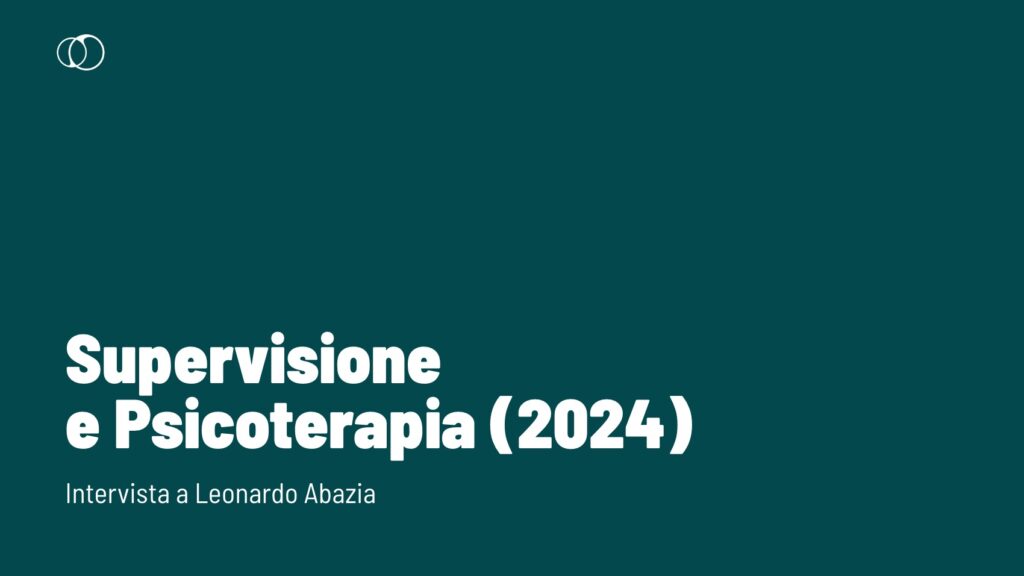
The interview with Leonardo Abazia
Where does the need of this volume come from?
This book takes shape from my supervision experience within a specialization school in psychotherapy. Over the years I have often found myself looking for texts that could offer concrete support in the practice of supervision, but I found a deficiency of materials that faced clearly and effectively the difficulties that emerge in this area. The publications available offered interesting theoretical ideas, but they lack a practical approach that could guide both supervisors and therapists in training in daily work. This lack has prompted me to collect the reflections, strategies and solutions developed over the years, trying to create a text that was not only theoretically solid, but also of real usefulness for those who face the complex supervision process. A further stimulus to the writing of this book came directly from the students, who often manifested the need for a clear and structured guide to orient themselves in the supervision path. To respond to this need, I included at the end of the volume a scheme with practical guidelines, designed to support students in the presentation and discussion of clinical cases, offering them a useful reference to better face this fundamental moment of training.
In Italy there are various models of psychotherapy, how is supervision positioned in this panorama?
Traditionally, supervision followed the theoretical setting of the reference therapeutic model, integrating aspects of content and process within a specific theoretical frame. However, with the diversification of psychotherapeutic approaches and technological evolution, new supervision methods have emerged that shift attention to the supervised, focusing on the construction of its skills and professional identity.
In the Italian panorama there are different types of supervision: teaching and clinical, direct and indirect, individual and group, as well as online and offline.
In addition, supervision varies according to the reference psychotherapeutic orientation: for example, in the cognitive-behavioral context, supervision is structured in a systematic and cooperative way, with the aim of increasing the therapeutic skills of the psychotherapist in training; In the psychoanalytic field, however, supervision is seen as a path of understanding of the psychic mechanisms, conscious and unconscious, of the therapist.
In recent years, a tendency towards integrated supervision models has also developed, which try to identify common aspects between the different guidelines, with the aim of creating an effective and flexible supervision, capable of adapting to the needs of the supervised and clinical context. In this sense, supervision in Italy represents a key element in the formation of psychotherapists.
In the book we speak of direct and indirect supervision, can he explain the difference and the strengths of one and the other?
Direct supervision provides that the supervisor observe the therapist in real time, through unidirectional mirrors or recordings, and in some cases intervene directly in the session. The main advantage is immediate feedback, which helps improve technical skills in a practical way. In addition, it is particularly useful in the early stages of training, offering direct guide in the management of the session.
In indirect supervision, the supervisor does not assist, directly, directly to the session, but receives information from the therapist through reports or recordings, providing feedback later.
This type of supervision promotes the therapist’s reflection and self -analysis, helping it to develop autonomy; In addition, it is more flexible, not requesting the simultaneous presence of supervisor and therapist. None of the two represents the most effective supervision ever, it all depends on the context and the training phase, the ideal is to combine them for complete learning.
In the other texts you have always made use of young collaborators, while in this book he was assisted by expert professionals, what is this choice due to?
The collaboration for this book has followed a different approach to previous works; In the past I have often involved young collaborators and trainees of the Campania Institute of Legal Psychology, while this time I considered the contribution of expert professionals, each representative of a different psychotherapeutic approach present in Italy. The intent was to offer an articulated vision of the different supervision practices in our country, guaranteeing a thorough analysis of each model. I therefore asked colleagues to explore and illustrate their reference approach, highlighting distinctive characteristics and guidelines. This choice responds to the need to provide readers with a complete and comparative picture of supervision in the psychotherapeutic field, allowing them to grasp the specificities of each method and to identify any convergence points. The final goal is to stimulate critical reflection and encourage greater integration between the different guidelines.
Can you talk about the type of audience to which this book is addressed?
This book is mainly designed for training psychotherapists, who are developing their clinical skills and need a solid reference on the different supervision methods. However, it can also be useful for professionals already started who wish to deepen the role of supervision in their practice or refine their working method.
By involving experts from different psychotherapeutic guidelines, the text offers a wide and structured overview, allowing the reader to compare different models and identify food for thought applicable to their experience. The goal is therefore to provide a small theoretical and practical guide that helps not only to understand supervision, but also to enhance it as an integral part of the professional growth of every psychotherapist.
Supervision and psychotherapy, a vital alliance: Leonardo Abazia’s new book
Leonardo Abaziapsychologist, psychotherapist, worked in the UOC of clinical psychology of the ASL Napoli1, teaching of the CIPPS and supervisor of the students of the fourth year, presents his new book published by Franco Angeli, Supervision and psychotherapy, a vital alliance. The work offers a historical and theoretical synthesis of supervision, deepening central themes such as transfer, countertransference, direct and indirect supervision, with or without sharing theoretical models. The goal is to integrate the different prospects on supervision, taking into account both the guidelines of the APA and the psychotherapeutic approaches spread in Italy. We had the pleasure of meeting the author to deepen the content of the volume.





